With the new rugby season starting in less than three weeks, there is nothing better for a player than to run out on to a good pitch that offers a thick sward to perform on, providing a level surface, that can take a stud and provide a cushion effect when making tackles.
Presentation is also important, particularly ensuring the pitch lines are accurate and straight. Take time to deliver a well-presented pitch, it will make all the difference and hopefully inspire your team to perform well.
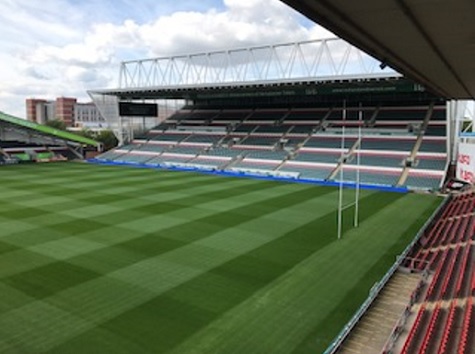
Leicester Tiger’s ground
There are a lot of rugby clubs however, who perhaps do not share the same philosophy. As a qualified groundsman and RFU Pitch Advisor, I sadly see too many clubs not investing enough time and resources into their pitches.
Which more than often leads to the grass not being cut regularly enough, no fertilisers being applied, no selective weedkilling and very little other work done on the pitches. Often the excuse is that they do not have the funds or the personnel to carry out the work.
At the end of the day there will always be a cost for this work - whether you do it yourself, with volunteers or employ a groundsmen / contractor. Many rugby clubs have many ex-players who if approached may be interested in helping. However, they will not want to carry out the job if it is seen as a chore, or if the club does not have the appropriate machinery, resources and equipment to do the job efficiently.
The RFU have for several years implemented a support programme called Groundsmen Connected under the guidance of Keith Kent Former HG at Twickenham. I myself recently attended one of Keith’s popular Groundsmen Connected roadshows at Veseyans Rugby Club, Warsall, Birmingham. In attendance were a number of local rugby club volunteer groundsmen who were keen to meet Keith and receive any relevant help and advice on looking after their pitches.
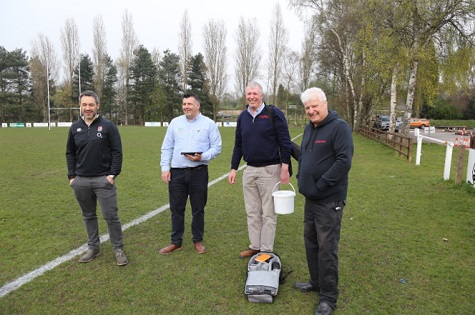
Keith Kent (right)
Rugby Groundsmen Connected (RGC) is the RFU’s easy access, two-way communication network between the RFU and rugby union groundsmen. It is the main communication channel for the RFU to provide information and advice to groundsmen and has special offers and exclusive benefits for members. Everything the RFU does related to pitch maintenance now comes under the banner of Rugby Groundsmen Connected.
Groundsmen Connected is for anybody that has any involvement in the upkeep of rugby pitches; from the complete novice to Premiership groundsmen. Anyone can register to join RGC at no cost. Once signed up turf professionals will receive regular communications with advice, information and the opportunity to ask questions.
RGC now has well over 1,000 groundsmen registered and Keith has been very supportive of the scheme and has himself visited many clubs up and down the country to pass on his advice. As a volunteer pitch advisor for the RFU myself, I was keen to meet up with Keith and offer my services to any local clubs. It is without doubt, a busy schedule for Keith. To date he had already visited over 30 rugby clubs up and down the country giving vital advice on pitch maintenance.
During each road show Keith is supported by several of the Groundsmen Connected partners who support the scheme and pass on other relevant advice to the attending rugby clubs.
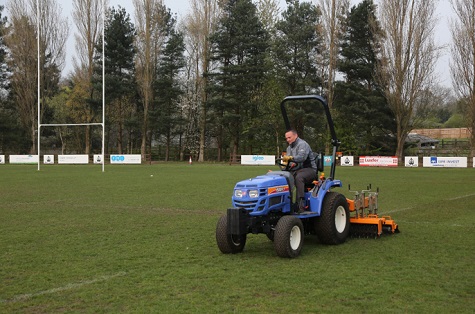
Iseki tractor and SISIS Quadraplay in action
The RFU do offer, under the Groundsmen Connected scheme a Keith Kent Maintenance Package that consists of Iseki Compact Tractor, SISIS Qudraplay unit, Wessex Roller Mower and SISIS Multitiner that would enable clubs to look after their pitches more professionally.
One of the most popular pitch management tools is the SISIS Quadraplay. The implement’s combination of frames makes up a single pass maintenance system which incorporates a mounted frame. The mounted frame accepts a variety of different implements for use on both turf and hard porous surfaces. Implements such as grooming rakes, spikers, slitters, rollers and brushes can be added to the frame, making this an exceptionally versatile piece of equipment. It can be used for fine and outfield turf to perform a range of tasks so effectively that you can aerate, brush, spring tine and roll in one pass.
Using these frames before and after matches helps keep the pitch in good condition and, above all, the spiker ensures the pitch is regularly aerated. In essence, maintaining natural grass pitches is all about supporting and promoting good grass growth throughout the year.
Personally, I believe buying your own equipment and building up a dedicated grounds team who can share and carry out the basic maintenance tasks is a better way to go. Yes, there is the initial cost of the equipment and a need to have a storage facility nearby. However, the benefits of doing the work yourself is not only satisfying, but you are in control of the performance and aesthetics of your ground. As for funding and getting enough money to undertake your own maintenance work, Keith and I have being saying for years that everybody (adults and youth sectors) who set foot on the clubs’ pitches (training and playing) should contribute a £1 a week towards the maintenance costs. For most clubs that would equate to well over £250 per week, £1000 per month, £9000 for 9 months. If you were to invest that into your pitches you would have some decent surfaces.
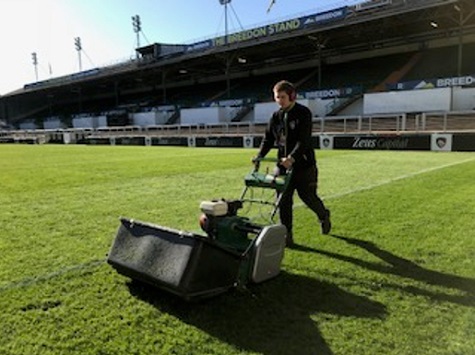
Mowing the grass at Leicester Tigers
Of course, rugby turf professionals should continue to cut the grass on a regular basis. The frequency of cuts will be dependent on growth. Ideally, we should be mowing on a weekly regime. Maintain the recommended height of cut, anything between 25-100mm. A lot of clubs are now using tractor mounted rotary deck mowers which are more robust with rollers that help produce a striping effect.
Marking out should be done on a regular basis to ensure lines remain intact - a weekly or fortnightly regime should suffice. Brushing the pitch is also beneficial. It helps stand the grass plant up and helps knock off early morning dews, which will also reduce the incidence of disease in the sward.
Monitor how the pitch is performing in terms of playability, keep on top of any worn areas by carrying out repairs and overseed whilst temperatures remain favourable for seed germination.
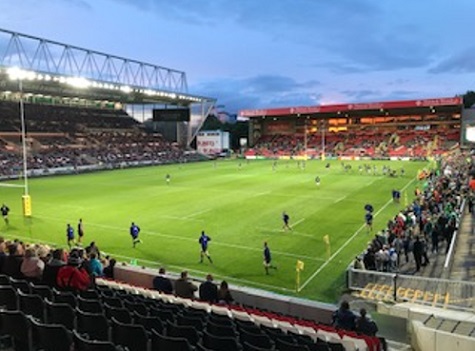
Well presented Leicester Tigers pitch
Also, encourage different parts of the sports field for warmups and training - this helps reduce wear.
With the season just starting, presentation skills will be at the forefront of the minds of most groundstaff, setting the maintenance standards for the coming season. Presentation and cleanliness are an important part of the job, ensuring the pitch is level, safe and appealing for play.
Some clubs are still using creosote or similar type products, to burn the lines in. This is not permitted; only approved marking products should be used. As for adding weed killers to line marking fluid, again this is not recommended. You will end up with bare soil lines, which are difficult to overmark. Use approved marking compounds/materials. There is a wide range of marking paints. Ensure you use the best product for your facility and needs, buying the cheapest paint is not always the best option.
I am sure we will see some decent looking pitches come September in time for the start of another competitive year of rugby fixtures. Not forgetting that this year, the home nation teams will be competing in the Rugby World Cup tournament in Japan.